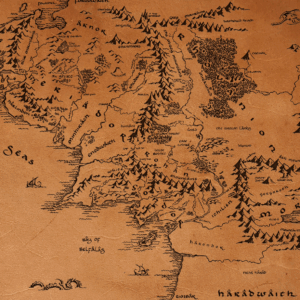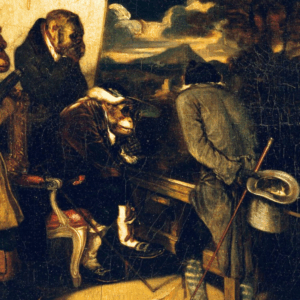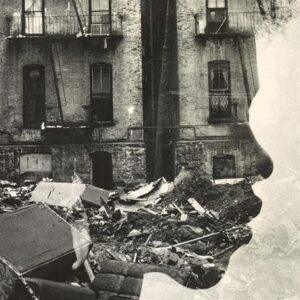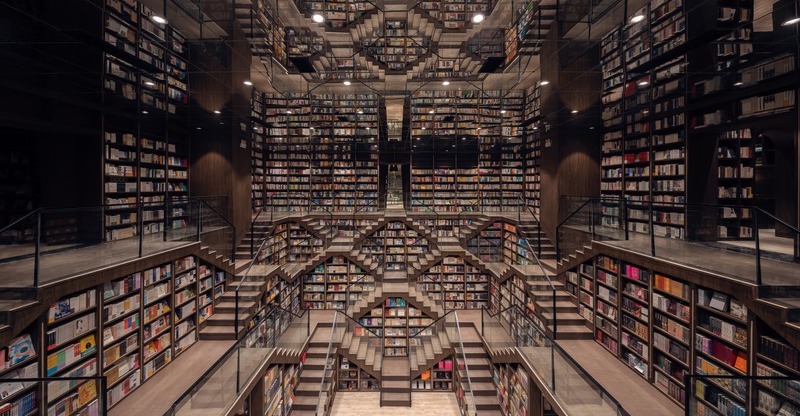
Inside China’s New Wave of Conceptually Innovative Bookstores
Jean-Yves Mollier and Patricia Sorel Explore Some of the Country’s Most Fascinating Reading Spaces
Prior to 2020, the city of Hong Kong had over one hundred bookstores, including several major chains. But the national security law passed on the heels of large demonstrations and the COVID-19 pandemic got the better of most booksellers. The same phenomenon hit the city-state of Singapore, where the book trade has distinctly declined despite enjoying a boom prior to 2019. So it was in the People’s Republic of China—specifically, Shenzhen, a city close to Hong Kong chosen by the central authorities to function as a free commercial zone—that Zhongshuge, one of the largest bookstore chains in the country, opened a branch in the fall of 2021, immediately hailed by the media as its most original venue.
Five years earlier, the store Zhongshuge opened in Hangzhou, the former capital of the Southern Song dynasty, had already surprised shoppers with its four distinct sections, the first of which resembles the command deck of a spaceship. Yet that was nothing compared to the chain’s later feat in Shenzhen: the store’s brash modernity was astonishing, being designed around a spiral staircase that, instead of rising vertically, was laid out horizontally, resembling a gigantic snake with rings of shelves crammed with books.
Once inside, customers are further surprised by a vast mirror covering the floor, which doubles the visual effect of this store created for the third millennium. Architect Li Xiang, founder of the X+Living design firm in Shanghai, visitors the impression of entering a rocket, whose speed is represented by the spiral staircase that takes them on a world-spanning trip. As at Hangzhou, Li Xiang divided the Shenzhen store into four distinct sections: a “concept” zone, a “forum,” a more conventional area aimed at children, and finally a conference room for events.
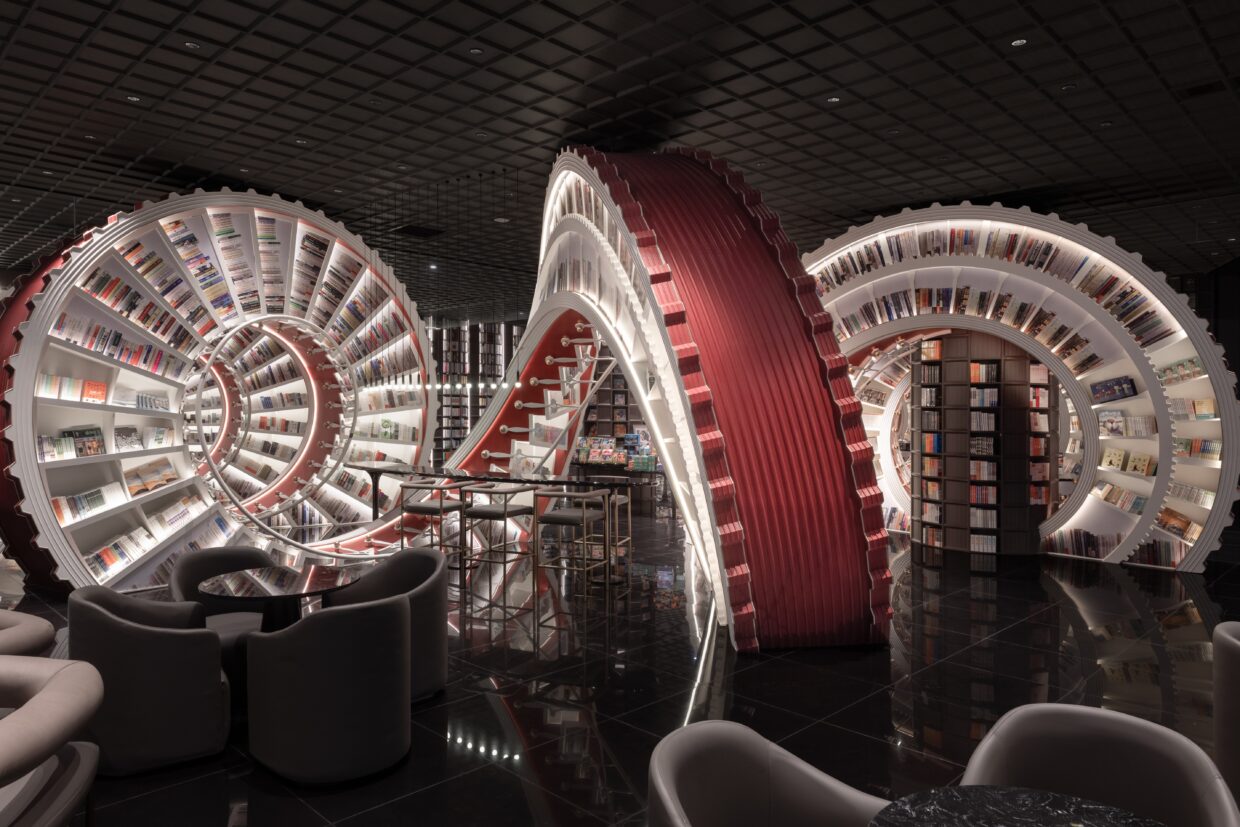 ZHONGSHUGE Hangzhou, China. This bookstore promises an otherworldly experience. The architectural designers of its reading nooks surprised people who never imagined that an outerspace theme could spark an urge to read.
ZHONGSHUGE Hangzhou, China. This bookstore promises an otherworldly experience. The architectural designers of its reading nooks surprised people who never imagined that an outerspace theme could spark an urge to read.
According to the chain’s own publicity, the Shenzhen store seeks to be a sacred temple of knowledge, in which the spiral staircase evokes the ladder of wisdom, the whole intended to create an absolutely unique “reading experience.” Li Xiang stated that the history of Shenzhen, a city of immigrants, inspired her to design an inclusive bookstore that would welcome all visitors and inspire them to buy the books featured on its shelves. Since 2010 the Zhongshuge chain has opened some twenty branches in China, in places like Beijing, Shanghai, Chongqing, and Chengdu (also startling in design).
It has succeeded in winning international press recognition as a highly innovative enterprise, even though its main source of income, books, has scarcely varied since 1450, when Gutenberg devised their current printed form. In a way, Zhongshuge’s determination to lead the way— to be on the cutting edge of advances in the book trade—reminds all its customers, whether in person or online, that China boasted bookstores long before the West did, and that booksellers were at work there even before the use of paper became widespread.
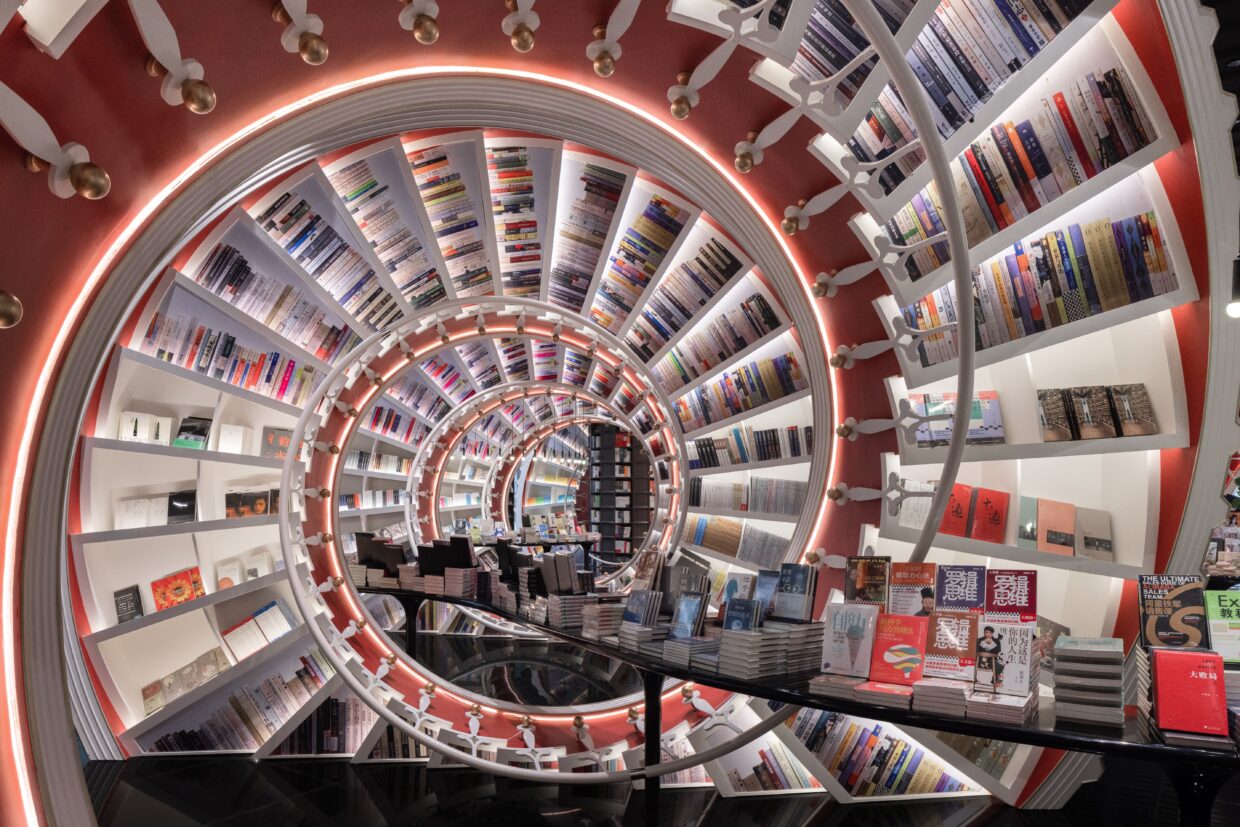 ZHONGSHUGE Shenzhen, China. World-encompassing bookshelves form giant spirals that hark back to 2001: A Space Odyssey (don’t worry, though: no aliens here). Readers will want to grab the books swirling around them in this head-spinning bookstore for the new millennium.
ZHONGSHUGE Shenzhen, China. World-encompassing bookshelves form giant spirals that hark back to 2001: A Space Odyssey (don’t worry, though: no aliens here). Readers will want to grab the books swirling around them in this head-spinning bookstore for the new millennium.
Like most large cities in China, Beijing—the national capital, with over twenty-two million inhabitants—suffered from the long business lockdown during the COVID-19 crisis. However, most bookstores there reopened in 2022, as distinct from Hong Kong (where the Swindon Books Company closed permanently in 2020) and Singapore (where BooksActually shut in 2021). Xidan Books occupies an immense five-story building in the Xicheng district of Beijing. Inscribed in capital letters on its facade are the identifying words “Beijing Books Building.”
Indeed, it is the largest bookstore in town, notable for a basement level devoted entirely to books in English, which draws expatriate readers from around the world. Similarly, one floor is dedicated to CDs and vinyl records, another features a tea-and-coffee room and space to relax, yet another floor has children’s books, and the final floor is for adult readers. Although there is nothing surprising about the building’s conventional glass-and-concrete architecture, the interior décor has been attentively designed to encourage customers to sit and read the books, hence they are entering a library, with countless shelves full of carefully arranged volumes, rather than a twenty-first century bookstore.
From this point of view, Xidan Books may seem to suffer from comparison with the Zhongshuge chain, whose outlets are drawing increasing numbers of Beijing readers thanks to interior design that catches the eye and spurs a desire to linger at length. Book lovers in Beijing are also increasingly drawn to the cosmopolitan city’s annual Literature Festival.
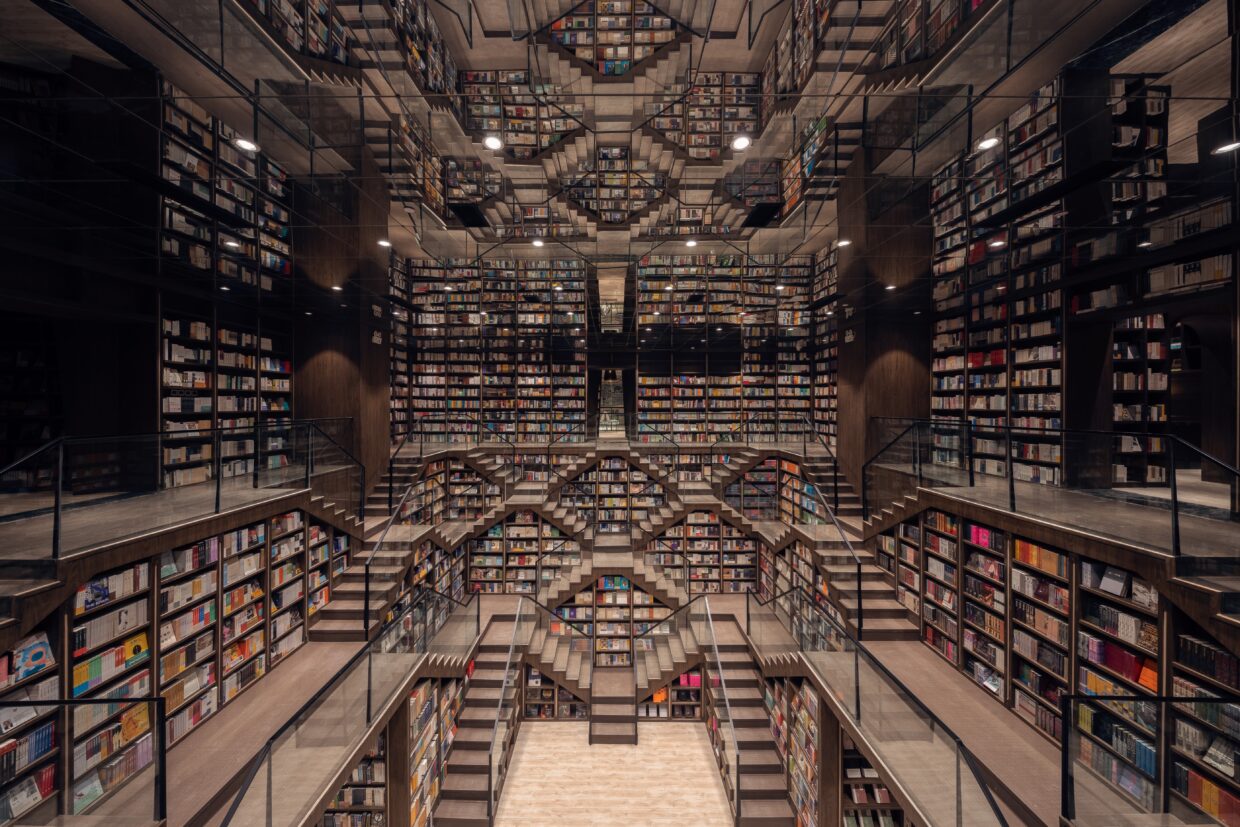 ZHONGSHUGE Chongquing, China. Once again, readers are awed by the vast scale of the store’s bookshelves.
ZHONGSHUGE Chongquing, China. Once again, readers are awed by the vast scale of the store’s bookshelves.
Still in Beijing, Poplar Kid’s Republic opened in 2005 and immediately felt at home in the capital. Owned by a Japanese publishing house, the bookstore benefited from a thoughtful and imaginative architectural firm, SAKO. The designers boldly used color to attract children and encourage them to return. More specifically, they used colors, plural—an entire rainbow of hues—to multiply the special zones where little readers could sit comfortably and browse as long as they wished. The gamble may not have seemed risky in China, where one-child families are ruled by a “little emperor” attended by six adults ready to sacrifice everything for that child’s future and well-being.
Yet Poplar Kid’s Republic still had to distinguish itself from the children’s departments found in other large bookstores. Conceived as a modern adaptation of Charles Vildrac’s early children’s book, Rose Island, this “people’s republic” for kids—as suggested by its name—is entirely designed to seduce the eye and ear. Indeed, many events, readings, and film screenings take place in the basement, the most fun area in the building. Upstairs, the shelves offer a wide range of Japanese and European titles as well as Chinese books
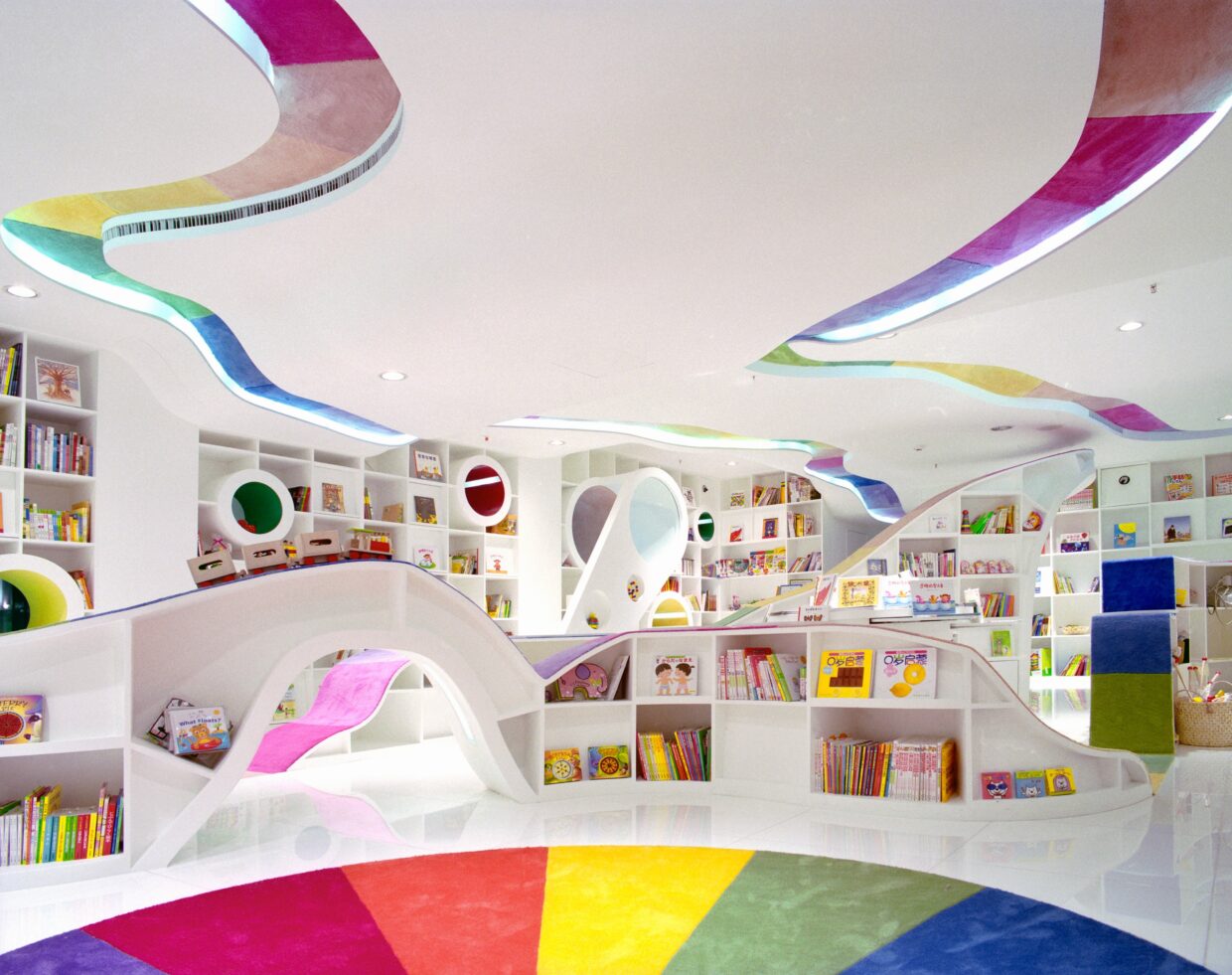 POPLAR KID’S REPUBLIC Beijing. This bookstore is an ode to joy—the joy of reading and living. Its cheerful, harmonious colors evoke the pleasure and leisure associated with reading from childhood onward. This is a kid’s republic.
POPLAR KID’S REPUBLIC Beijing. This bookstore is an ode to joy—the joy of reading and living. Its cheerful, harmonious colors evoke the pleasure and leisure associated with reading from childhood onward. This is a kid’s republic.
All visitors are struck by the long colored ribbon extending over a hundred yards throughout the store, drawing them inside to experience all its shimmering hues. As in Alice’s Wonderland, where rabbits talk and carry watches, the children who wander through Poplar Kid’s Republic forget the real world as they embark on an extraordinary adventure, drifting farther and farther away from adults. The permission to lie down wherever they wish, adopting the most comfortable position, must have surprised young Beijingers when the store first opened, but its popularity proves that they like the new freedom.
Just watching them, totally absorbed in what they’re reading, reveals Japan’s masterstroke in offering Beijing children open access to a freely chosen cultural pastime. Without acknowledging it, this bookstore is a synthesis of every experiment in children’s literature from Babar the Elephant and the Pere Castor series in France to Mickey Mouse and cartoons in the United States, via innovative graphic design in Czechoslovakia and Russia in the interwar period.
__________________________________
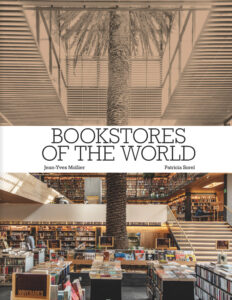
From Bookstores of the World by Jean-Yves Mollier and Patricia Sorel. Copyright © 2025. Available from Abbeville Press.
Jean-Yves Mollier and Patricia Sorel
Jean-Yves Mollier is a noted scholar of contemporary history who teaches at Versailles Saint-Quentin-en-Yvelines University. He has published numerous works on the history of bookselling and publishing.
Patricia Sorel, who teaches at the University of Paris Nanterre, is also an authority on bookselling and publishing.










